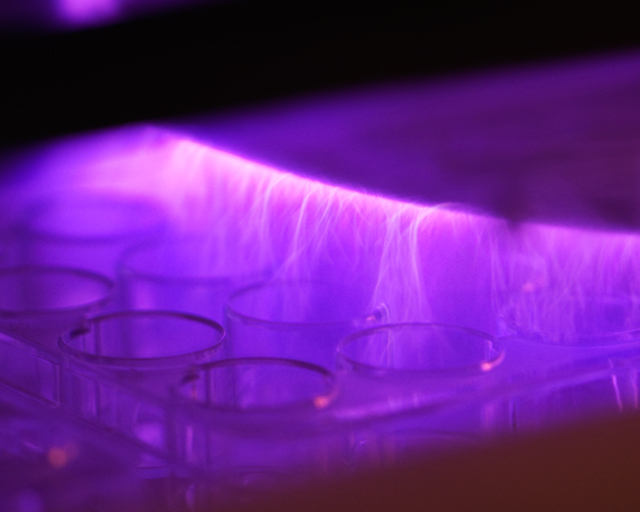Fraunhofer vs. Corona
Facing the crisis together: Ideas and solution approaches from the Fraunhofer IST
The corona pandemic presents major challenges for society, the economy and science. The common goal must be to find a way out of the crisis as quickly as possible, whereby the protection of humans must remain the number one priority. The scientists at the Fraunhofer Institute for Surface Engineering and Thin Films IST in Braunschweig are also making an important contribution by means of their developments, the activation of their networks, the evolvement of their project ideas and their support of the economy and society in coping with direct effects and subsequent consequences. A number of projects are thereby being funded directly by the Fraunhofer-Gesellschaft using internal resources within the framework of the central action program “Fraunhofer vs. corona”.
Surfaces play a central role in the containment of the SARS-CoV-2 pandemic: from the sterilization of clothing and medical equipment through to the development of diagnostic and biosensor systems. With its expertise in the research and development of surface technology and competencies in the associated product and production systems, the Fraunhofer IST is making an important contribution towards combating the corona pandemic by means of numerous projects, some of which are funded via the central action program of the Fraunhofer-Gesellschaft, “Fraunhofer vs. corona”:
At present, there is a lack of suitable protective clothing for medical staff and care workers. Respiratory masks in particular are not available in sufficient numbers. As a result, prices have risen drastically. A sustainable possibility for counteracting these shortages and, at the same time, reducing costs is to sterilize masks so that they can be re-used several times. An important prerequisite for this are suitable test procedures with which not only the sterilization effects but also the particle permeability and material density following sterilization can be tested validly and reproducibly. Together with the Städtisches Klinikum Braunschweig, the Fraunhofer IST is pursuing this approach to attaining the possibility of safe multiple use of FFP2 masks and has launched a project in order to further develop this procedure and to validate the results.

An important field of research at the Fraunhofer IST concerns atmospheric pressure plasma processes. This technology provides the institute with a vast range of possibilities and approaches for the development of sterilization processes, e.g. for textiles or plastics through to air sterilization. The principle: discharges, so-called cold plasmas, are generated by means of electrical fields inside a container through which air flows. As a result, reactive gas species are created from the nitrogen and oxygen in the air, with which germs, including viruses, can be inactivated.
Time and again, discussions on reducing the risk of infection with coronavirus also call for the appropriate disinfection of surfaces with which people are in constant contact in everyday life, e.g. door handles in shops, handles on public transport, etc. An alternative to wipe disinfection could be a virus-killing coating. The Fraunhofer IST has extensive experience in the development of very thin, wear-resistant hard coatings. It is here that the scientists see promising starting points for the development of antiviral coating systems through the application of antiviral additives. Furthermore, antiviral coatings are also conceivable for use on textiles - from protective clothing through seat covers and on to drapes.
Moreover, photocatalytic coatings are a topic at the institute. In combination with UV light, these coatings can not only kill bacteria and fungi but also possess antiviral properties which have been proven, for example, for hepatitis B and rotaviruses.
In addition, the Fraunhofer IST is also developing other possibilities for disinfection. These include the use of diamond-coated electrodes to generate and enrich disinfection agents such as ozone or hypochlorite which, for example, also kills HIV and human influenza viruses - quickly and without significant effort, directly in the water. The Fraunhofer IST is currently investigating the possibility of obtaining approval for the provision and utilization of these products within the framework of the EU Biocides Regulation.
In order to ensure optimal treatment of COVID-19 patients with confirmed pneumonia and to determine the point at which artificial respiration becomes necessary and how long non-invasive ventilation is still sufficient, reliable monitoring of the patients' breathing is necessary. This is currently extremely complex and time-consuming. In addition to the respiratory flow, the pressure is also an important measured parameter. The Fraunhofer IST develops thin-film sensors for pressure measurement. These are inexpensive to manufacture and can be easily integrated, meaning that thin-film sensor technology can offer starting points for simplified solutions in this respect.
Furthermore, the technologies available at the Fraunhofer IST can also be applied to support the development of diagnostic and biosensor systems as well as medication advancement. This enables surfaces with functional groups to be produced to which differing biomolecules can be coupled. In addition, suitable barrier layers can be incorporated in order to influence the diffusion properties of particles, for example to control the release of medication.
The examples and ideas mentioned here provide only a small insight into the possibilities offered by the Fraunhofer IST coating and surface technology capabilities. Whether in the home office, in the laboratory or in the office, the employees of the Fraunhofer IST are working intensively on new developments, not only to make an immediate contribution towards solutions for overcoming the crisis but also to sustainably strengthen economic development in both the medium and the long term through cooperation with industry and research.
Last modified: